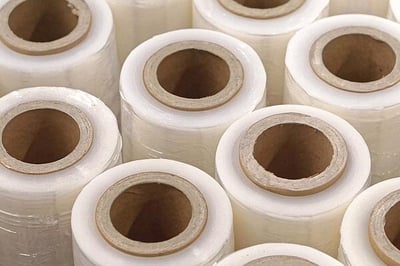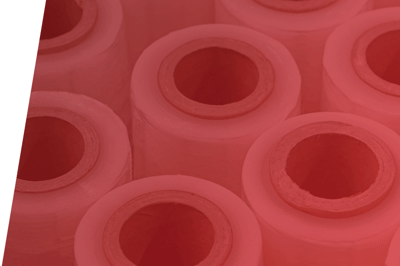Are you looking to stretch your knowledge about this particular type of flexible film? Want to wrap up any pending questions you have about this material?
OK, two bad puns right off the bat are a bit much but don't worry, the rest of the article is far better than my comedy skills!
Stretch wraps (which are also known as stretch films) are one of the most popular types of flexible packaging materials on the market. Countless businesses use stretch film to palletize and properly contain loads.
But, which type of stretch film is right for your needs? And what are the answers to the other important questions you need to answer before making a purchase?
This article will present the top 5 questions about stretch film and answer each of those questions completely.
With the information in this article, you will be able to figure out which type of stretch film is right for you and your needs.
What Are The Top 5 Questions About Stretch Film?
Should you wrap your feet in stretch film? Just kidding! Boy, I really shouldn't quit my day job, huh? All right, that's enough of these nonsensical attempts at humor; let's get down to business!
Below, we will explore the top 5 questions about stretch film so that you are armed with the proper knowledge required to buy the correct type of film.

What Is The Difference Between Cast And Blown Stretch Wrap?
Stretch films are generally divided into two categories. These categories include cast stretch film and blown stretch wrap.
Below, you will find an in-depth description of each of these films. With the information therein, you will be able to choose the film that best suits your needs.
Cast Stretch Films
Cast stretch film is created via the application of an extensive manufacturing protocol, most commonly known as cast extrusion.
This process operates through the continual thrusting of a substrate with high thermoplasticity inside of a flat die and onto a cool roll.
The thickness of the film (or gauge) forms as the result of how fast the casting roll draws the plastic from the die.
This operation results in cast films boasting superior transparency, allowing end-users to see the wrapped objects within.
Cast films stretch much easier in part due to the molecules of the substrate being aligned during the extrusion process.
Cast stretch film is notably quiet when being taken off of the roll and stretches with relative ease. It also provides a classic two-sided cling that allows the wrapped product to remain firmly wrapped during shipping.
Although cast stretch film features multiple impressive attributes, including a more affordable price point when compared to blown film, it produces no competition to blown varieties in sustained strength or tear resistance.
Cast stretch film will usually stretch with ease. Still, it does not feature as robust a stretch memory as blown film.
Blown Stretch Films
Blown stretch films are literally blown into form through a process known as blown extrusion. This procedure involves the use of plastic melt, which is pushed through a circular slit die. In turn, this results in the formation of a subtle tube.
Next, air is thrust into the tube, which in turn causes the volume of air enclosed to broaden the tube to the desired width.
The tube is then capped with a ring of air that is then blown onto the material to cool.
This operation of cooling the substrate gives blown film an increased strength and notably more flexibility than other wraps.
Key Takeaways On Cast VS Blown Stretch Film
Traditionally, blown film was:
1) softer and more flexible
2) less likely to puncture
3) better in cold temps
4) 5-8% more expensive
However, in regards to modern films available today, blown film is only better in cold temps and applications that produce severe tearing. In today's market, it is almost always more expensive.
How much money will you save with automated stretch wrapping?

Which Type Of Stretch Wrap Is Better, Cast Or Blown Film?
Most of the time, the cast film production process will produce a better-quality stretch film with a more uniform gauge and better cling consistency.
However, blown stretch films offer better tear resistance. So, if you are looking to palletize products that are more likely to tear the film, blown films would be a better choice for your needs.
Can A Thinner Stretch Film Be Stronger Than Higher Gauge Wraps?
While it may come as a surprise, there are some thinner films that are stronger than films with higher gauges. This is due to the ongoing evolution in the technology of film manufacturing.
Because of the advancements in these technologies, new thinner films with multiple layers can achieve greater strengths than traditionally thicker or higher gauge stretch films.
From a sustainability standpoint, these thinner yet stronger film formulations use less plastic, making them a more environmentally friendly choice without sacrificing strength.
Why Do Stretch Film Prices Fluctuate So Often?
Stretch wrap is made of plastic. Plastic flexible films are made from plastic resins. Plastic resin is a petroleum by-product.
Because of this, fluctuations in the oil industry will cause changes to the resin markets, which in turn cause further changes to the cost of stretch wraps.
Usually, the price of plastic resins will change anywhere from 3-9 times per year. These price increases or decreases will be reflected in the cost of stretch films.
However, various global supply chain disruptions will often affect these price fluctuations.
For example, due to the recent conflict in Ukraine, oil and gas prices have been rising quickly. These price increases will likely have an effect on the resin market.
As such, you can expect further fluctuations in stretch film prices as the reverberations of this conflict are felt at the gas pump.
Other global supply chain disruptions may also affect the cost of stretch film as time goes on.
What Is The Best Way To Evaluate The Cost Of Stretch Wrap?
Like BOPP film, stretch wrap is sold by the pound. However, the film is utilized by the foot. While a superior stretch film may cost 15% more, it could provide up to 50% better performance than a standard product.
Because of these dynamics, the roll with a higher price point by the pound may yield significantly more wrapped loads per roll.
The best way to choose the proper film for your applications and budget requirements is to speak one-on-one with a packaging specialist.
They will be able to help you identify which brand, gauge, formulation, and type of film are best suited for your needs.
Which Is The Best Brand Of Stretch Film For You?
With the answers above, you should be able to figure out which type of film is right for palletizing and containing your products.
But which brand of film is the proper choice for your business? Would you like to identify the brand that is right for your packaging applications?
If you answered yes, then you would want to consider reading this follow-up article, The Top 7 Absolute Best Brands of Stretch Film For Shipping Protection.
With the information in this article, you will be able to select the perfect stretch wrap for all of your product palletizing requirements.
About Nathan Dube
As the Digital Marketing Specialist at Industrial Packaging, I am honored to create content for such a phenomenal company and work with one of the greatest teams in the Packaging Industry. Whether creating a video, writing blog posts or generating other pieces of content and multimedia, I am always excited to help educate and inspire our prospects and clients to reach their highest potential in regards to their packaging processes and needs.




